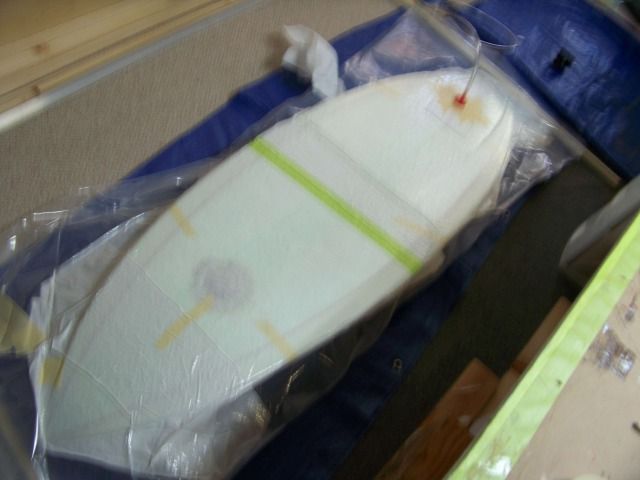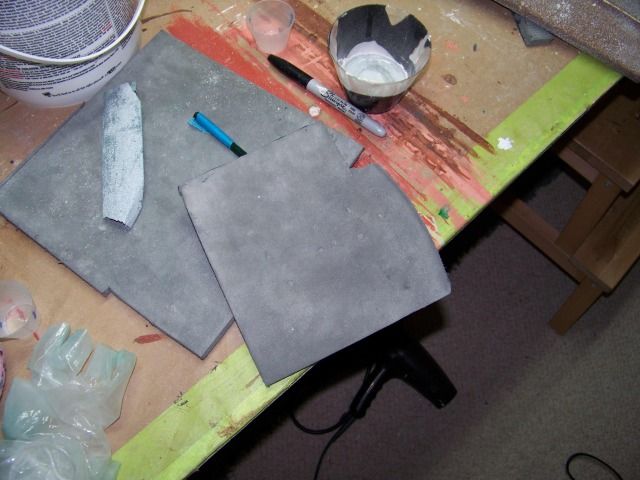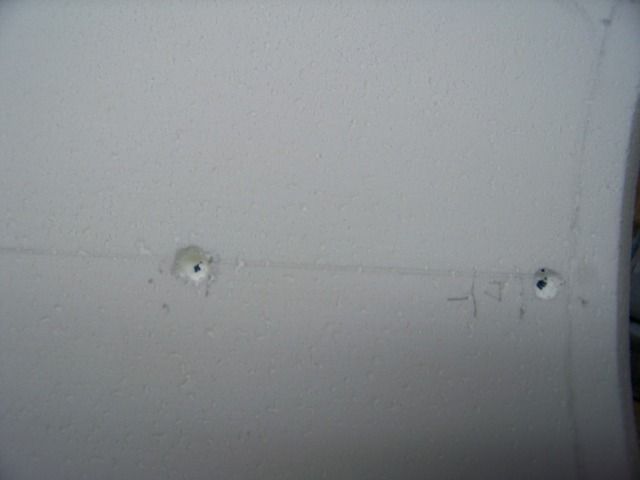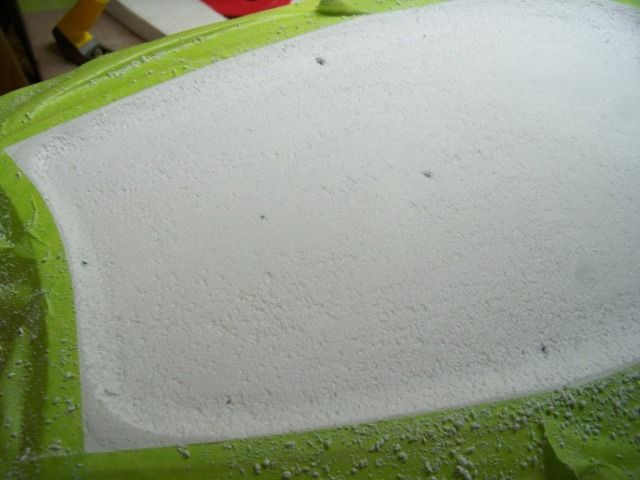OK. I’m no longer a virgin! I have (with the help of a friend) bagged my first lam (sounds like slang in the making)!
I am disappointed and relieved. Disappointed because I ended up using much more resin than I thought I would, and, also because there were some air bubbles, more air bubbles than I would have had, had I hand lammed. It has left me wondering what the utility of bagging the lam is?
I couldn’t take pics of the process because, my helper (thanks Andy!) and I both had our hands full. So I’ll explain the process for the edifictaion of neophytes, and so that the maestros, if they are so inclined, can comment and correct my errors and bugs (little sways inside joke humor there).
First I sealed the EPS portion of the blank (with Kwik Kick), as per Plusone’s advice. Waited a couple of hours. Then laid out my cloth. The first layer was the skinz. The skinz really wanted to stick where I put it, due to the texture left on the EPS by the seal job. The skinz reminds me of the fiberglass matt we used at the boat builder. It, too, was always used between the foam cores and the fiberglass roving.

I could foresee problems already.
We then laid out the 4oz S cloth and then another layer of skinz. Cut it all to fit . Then peeled the layers back off the front half of the board and proceeded to roll the resin (now using RR Slow). When we pulled the skinz back down onto the blank we immediately noticed two things- one it doesn’t soak up resin, at least not immediately like cloth would. Two, the foreseen problem- it would not lay down very well, especially on the laps. I will never again lap skinz! I had to make several relief cuts and it took 20 minutes to get the front half down. And that was just the skinz! And that was the easy half! Then we peeled back the back layers from the tail, rolled the resin (this time more generously) and started to lay down the back half of the skinz over the ewings and channels and tail tips…and by the time we got that done I was going into panic mode! Almost 40 minutes and all we had down was the skinz! With two of us working!
I should mention my friend Andy has made many surfboards but never with epoxy and he was curious to see what I was up to. So now nearly forty minutes into it and we had the first layer of skinz down. We then laid out the cloth and poured the resin, moved it around and started the normal glassing phase. Now I don’t know if it was the skinz underneath or the resin starting to go off, but it seemed to move slower than normal and I decided we’d better mix a little more, just so we could wet the laps without too much mucking around. I had origianally mixed 15 oz. I mixed 3 more which seems a lot for a bottom lam on what is supposed to be an ultralight board.
I should mention that when we tucked the channel, air bubbles formed at the Ewing and when you tried to tuck the ewing, the channel would bubble…At a certain point I said, “F—k it. I’ll fix it later. And forget the outer layer of skinz! Let’s get it in the bag!”
And then, “Oh wait, the logo laminate!” Too late to go under the cloth. I slapped it down on top and put a piece of 2oz cloth over it.
By that point over 50 minutes had passed which is RR slow’s pot life. You could feel the resin gelling. So we wrapped it with the shrink wrap. In my mind, before actually doing this, I intended to be very meticulous about the wrapping. I had seen in my test panels how the wrinkles show, thus I had intended to get all the wrinkles out. But at this point I was in panic mode. So we wrapped it hastily, put the breather cloth over it and got it sealed in the bag. Pump on. Done. One hour and 8 minutes after mixing the first batch of resin. Whew. We needed a beer at that point.

Sorry this photo is blurry. I was probably shaking by that point. Andy had a stunned look on his face.
So how’s it look…like I said at the beginning it could be worse. When I first took it out of the bag it looked like it had air bubbles everywhere, but I couldn’t tell if it was the peel ply or the lam. Although the resin in the cup was solid the board still felt soft so I started poking the airbubbles and squeezing them out.
After I got the peel off I’m thinking they were mostly the peel ply. Still the lam had a bubble here and there, something I almost never have when hand lamming. And there were wrinkles everywhere.


One good thing, the channels and ewings pulled tight with just a couple of bubbles. There is, however, a radius of resin in the channel now. I’m not sure that a good thing, seems to defeat the purpose of the channel. Don’t know of I should grind it out. Probably not since there is no more glass going over it.
One bad thing, I don’t know if it was the fact of bagging or what, butwhen I went to peel the tape after cutting the lam beads were coming off with the tape, something that’s never happened to me before. I would complain to the company but they are out of business (Warvel).


More spackle, the creeping evil…
Whew. What did I learn? I will never lap skinz again.



















